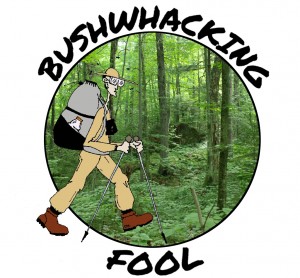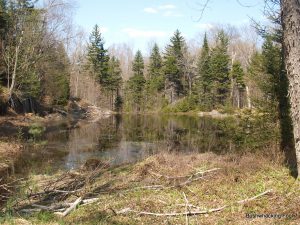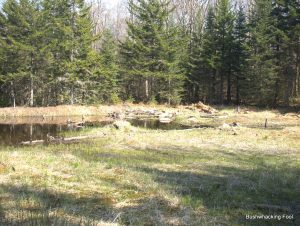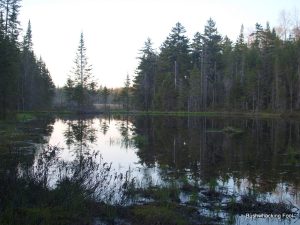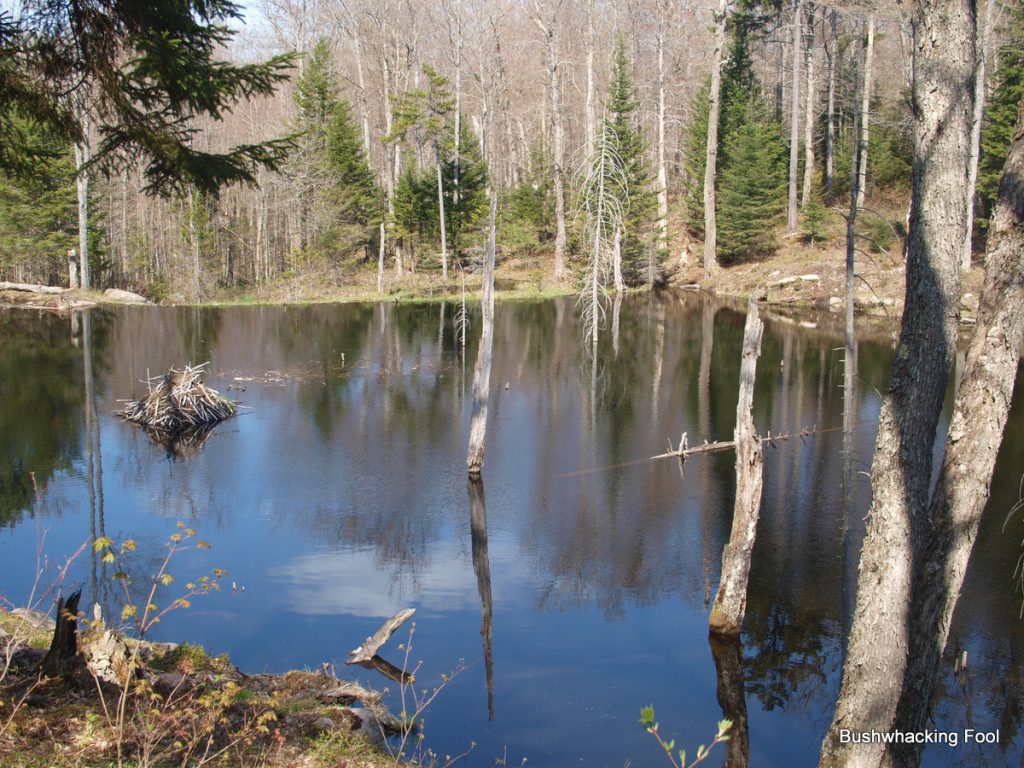
On the day before the Birdathon, I have a single goal; get into camp in the Pepperbox Wilderness backcountry in a timely manner. When doing so, the ample daylight remaining allows for accomplishing all the necessary chores, packing up for the next day and making it to bed early enough so I get plenty of rest before the big day. Unfortunately, it rarely works out this way, and this year appears to be no different.
Date: May 20, 2016
Length: 2.4 miles (5.6 day, 5.6 trip)
Difficulty: Moderate (bushwhack)
With mid-afternoon approaching, the long hike up Raven Lake Road and the bushwhack to a viewpoint overlooking the area around Shallow Pond are already under my belt. As a clearing begins to appear apparent before me in the forest, marking the first in a series of four ponds, I realize I still have another couple mile hike north along a series of four ponds before reaching the northernmost pond, where I plan making camp for the night. All plans of getting to camp early now appear to rely on the remainder of my hike being an easy jaunt in the park.
The chance of this is not bloody likely, but I can always hope.
Exploring Fourth of Four Ponds
When I finally breach the thick young trees surrounding the southern end of the southernmost pond, which I christened Fourth of Four Ponds, I see something I did not quite expect. Instead of a slim pond as indicated by my topo map, I find a meadow instead, with no open water in sight. Where there should be open water, the meadow’s interior is lush with grasses and/or sedges, with some forbs mixed in as well as a few young trees, both hardwood and coniferous. Beautiful and scenic, there is no question, but totally unexpected.
From my location, the southern end appears drier and more grass covered, while it gets wetter farther north, where sedges appear to dominate. Young hardwoods (mostly red maples) dominate the edges, although much of the hillside making up the western shoreline appears rather devoid of trees altogether, apparently evidence of past beaver activity. Conifers remain scattered about, obvious within the naked hardwoods, still mostly devoid of their leaves.
With the western side containing a lower density of young trees, I decide that is where my destined route lies, especially since I cannot afford to waste any time. As I attempt to cross the meadow, it gets too soggy for my liking, so I retreat upslope a little way to avoid getting my boots wet. Continuing along the meadow’s western edge, it clearly gets progressively wetter the farther north, until the clearing finally ends at a dam where the hills on both sides naturally come together. Clearly, it was once an opportunity that some wise old beaver could not let pass up.
The dam has been long breached now, with tree branches sticking out in all directions within a gaping wound in its center. Back to the south, in the direction I just came, is where the pond was once located, as evidenced from its placement on the topo map. This pond is now long drained of most of its precious water, while to the north lies its descendent, as the open water reflecting the plentiful sunshine attests.
By the time I reach the dam, the sky is clear, with a steady breeze blowing, making the dam a perfect place to provide a reprieve from the constant onslaught of the black fly horde pursuing me. A glance behind my head reveals something truly horrifying, as the black flies are just hiding on the leeward side of my head, ready to reengage with my exposed skin as soon as the breeze allows.
From the dam, I head further north to the edge of the newer pond. It is still somewhat grassy for the short distance between the dam and the murky pond, with a narrow channel of water meandering through the vegetation. Along the pond’s western shore are rocky cliffs with no shoreline to speak of, so to continue following the western shoreline is no longer an option for me. Some conifers stand guard along the eastern shore however, but hardwoods still dominate the surrounding forest.
The pond has sedges peaking above the water at its southern end, while to the north there appears to be a thick submerged forest of some type of aquatic vegetation of which I am unfamiliar – seaweed comes to mind though. The aquatic vegetation appears to form a significant mass underwater, giving fodder to my imagination of a large ancient evil entity living beneath the surface, which could emerge at any moment and pull me down into the dark depths. Luckily for me, the only movement in the water is a lone beaver, navigating through the vegetation mass as if it were not even there.
With more ground to cover and the afternoon slowly slipping away, I continue northward toward my destination for the night; only three more ponds to get around now. Unable to follow the pond’s western shore much longer, and unwilling to backtrack to cross the ruptured dam, I turn west into the forest to get around the rock cliff shoreline. After going a short distance within the forest, I return to a northeast heading, paralleling the stream that connects these four ponds.
Moving on to Third of Four Ponds
It only takes a short time before the second pond is visible through the trees. Third of Four Ponds is smaller than its cousin to the south, although the open water might amount to about the same. It is a round little pond, apparently deeper and darker than its southern neighbor, with less vegetation growing from the shallow water along its shore. A beaver lodge rises from the Stygian depths, while several snags emerge scattered throughout the water. Hopefully, this pond has no aquatic vegetation creature in it either.
Although an interesting little water body, I do not linger long. The afternoon is winding down and there is still much to do once I make camp. Before departing, I observe a solitary sandpiper lurking along shore, probing the bare mud along the pond’s shore. Hopefully, it will make an appearance tomorrow when I really need it, though I doubt the Birdathon is on its agenda for tomorrow however.
The stream provides my guide to the next pond, although I do my best to stay upslope to avoid any more pointless ups and downs that might occur from staying too close. While continuing through the mixed forest, I suddenly cross a trail, complete with homemade orange-colored plastic markers. My guess is that this is the same illegal trail I used last year to get to Big Bad Leroy Bog.
I start thinking about just camping near the trail instead of continuing. Since the trail is not an official New York State trail, there are no regulations about camping within 100 feet of it, so I could just plop down right in the middle of it and the worst thing I would have to worry about is some animal wandering into my tarp in the middle of the night. But if this creature thinks I am sharing my sleeping bag though, it has another thing coming to it.
Fortunately, common sense prevails over my innate laziness, and I continue toward my original destination at First of Four Ponds. My people in the frontcountry believe my camp is going to be at the first pond for the night, so come Hell or high water; I am going to make it there, regardless of how tired I am.
The unofficial trail goes to Raven Lake to the east and parts unknown to the west, neither of which are of any interest to me at this very moment. Instead, I continue along the stream, eager to see what the second pond in the beaver pond series looks like. Unfortunately, this new pond turns out to be quite a bit less attractive than the previous two; in fact, it is not much of a pond at all anymore.
Second of Four Ponds is Not a Pond at All
When I finally exit the forest, the second pond is just a sliver of a meadow with a stream meandering through it. Grasses and sedges line the stream, along with an occasional bleached log and some exposed mud. At the far end, a low beaver dam snakes its way across the clearing, connecting a few small treed islands. The dam is breached to the west where the stream exists, apparently making its way toward the first pond.
The meadow is wet, so I stay to the west in the forest, keeping the meadow in view through the trees as I make my way to the northeast where I hope to find the final pond in the series of four. There is no time to waste checking out this empty meadow, as it is nearly half past three now, and there are many chores waiting for me once arriving at my inevitable campsite for the night.
The forest becomes noticeably more coniferous as the terrain levels out. The stream seems to flow in every direction now, and my desire to maintain my dry boots pushes me northward. Unfortunately, unbeknownst to me, the actual stream to the First Pond turns directly east before reaching its inevitable destination.
In my hurry, I fail to consult the GPS, and instead continue off to the north despite the conditions becoming increasingly more difficult to navigate through, due to the thicker coniferous nature of the forest. When I reach a flowing stream, I finally decide it might be time to check a map or GPS, and doing so reveals that I am way off to the north of my destination, with Big Bad Leroy Bog just a short distance to my east.
Once again, I contemplate setting up camp nearby instead of continuing on. After taking a moment to mull the idea over again, I decide to push onto First of Four Ponds, and keep to my original itinerary. Plus, the GPS indicates it is only two tenths of a mile away, so it should not take long to get there.
With very little energy in reserve, I bushwhack south for a while following the GPS’s direction, until it changes everything up and indicates the pond is to the southeast instead. Instead of following the fickle gadget, I head directly to the edge of the bog, which I can now see through the trees. From there, the edge of the bog guides me south as I move out into the relatively easier walking out in the open. Unfortunately, the bog turns too soggy for my liking, forcing me back into the forest, until I start making out a beaver dam, with a small pond behind it.
Finally! I made it!
Finally Arriving at First of Four Ponds
The pond is rather small, but at least it is open water and devoid of the submerged vegetation like its two cousins to the south. The beaver dam is low and meandering, with wet vegetated areas downstream toward the bog rather than a really well defined outlet. The dam appears somewhat ill-constructed, as if it can barely hold back the water on the other side.
I spend little time admiring the beaver’s handiwork (or lack thereof), as I get about looking to set up my campsite for the night. Unfortunately, I am hungry, tired and more than a little irritable about the biting flies, so there is little time to play tourist right now. The western shore is the most convenient place for me to start tomorrow morning, so I begin searching there for an adequate campsite, but find little in the somewhat dense surrounding coniferous forest. When I finally arrive at the inlet stream at the southern end, a flat enough place to set-up my camp presents itself.
The noise from the rocky stream gives me pause however. How am I to hear birds over the noise of the stream tomorrow morning? The sound is not excessively loud, but probably enough to drown out far off birds though. But I cannot afford to lose even a few opportunities to pick up bird species either.
After some thought, I decide to move back toward the dam and inland farther. The trees look scattered more uphill and away from the pond, which might mean I am less likely to poke out an eye during a late night pee run or a good birding opportunity in the early morning. Much to my relief, it only takes a few minutes before I find someplace that works.
As I attempt to put my tarp up, the guide lines get all tangled in the surrounding softwood twigs, irritating me to no end. While attempting to untangle them, the local black fly population takes a bead on me and savagely engages in an onslaught, with me being ground zero. It becomes so agonizing that even my legendary tolerance is no match for it, so I throw the tarp over myself as I work to untangle the lines. Ah, the peace of not being bled out.
When the tarp is finally up and populated with my sleeping gear, I perform my other necessary chores before calling it an early night. Dinner is the first priority, but while it heats up, I go about filtering water from the nearby inlet stream. I skip the nearer murky water of the pond, as its appeal is less than, well, appealing.
By half past eight, I am comfortably under my tarp and ready for sleep. Today was a long rough day, and tomorrow is likely to be even longer, so I need all the sleep I can get. Plus, I expect to be up at midnight to try and get an owl as my first bird of the Birdathon too. Tomorrow is all about the birds, after all.
For tonight it is all about the amphibians, as numerous spring peepers serenade me into sleep, with just a few American toads adding to the chorus nearby. Drifting off, I remain hopeful all this will be worth it and the reward for my efforts will be a plentiful count of bird species.
One can always hope!
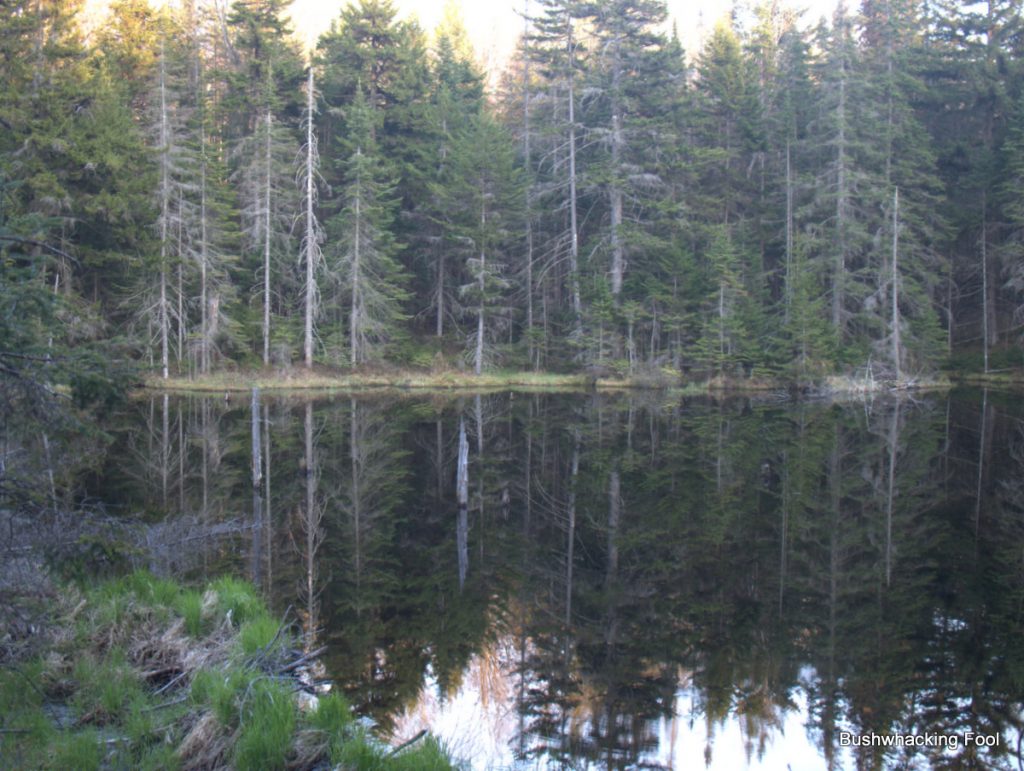
Affiliate Disclaimer: Some links and advertisements on this blog post and elsewhere on the Bushwhacking Fool may send you to a retailer’s website. If you chose to purchase any products from this retailer, the Bushwhacking Fool may receive a small commission at no extra cost to you. These commissions provide compensation for the time and effort necessary to provide the content at the Bushwhacking Fool. If you enjoy the content on this website, please consider showing your appreciation by purchasing products through links and advertisements on this site.
